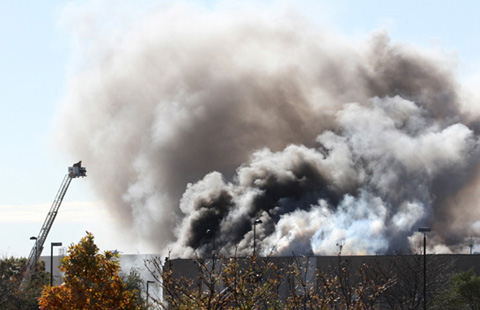City to study disease-smog link
Updated: 2014-10-31 14:03
By Li Yang in Shanghai(China Daily USA)
|
||||||||
|
The Shanghai government issues an orange alert on Dec 6 during one of the most serious smog days in the city. Gao Erqiang / China Daily |
Shanghai will become the first city in China to study the relationship between air pollution and respiratory disease.
The Shanghai municipal public health authority, in response to last week's smog that shrouded North and East China, including Shanghai, will conduct a survey on air-pollution-related diseases and the need for precautionary respiratory disease treatment for infants, pregnant women and senior citizens.
The density of PM2.5, particulate matter smaller than 2.5 micrometers in diameter, in the air over the affected areas was10 times the safe limits set by the World Health Organization.
Hebei province in North China is believed to be the main source of China's smog. Similar in size to the state of Washington, Hebei consumes nearly 300 million tons of coal a year, 5 percent of the world's consumption. The province has about 150 iron and steel factories and produces nearly 25 percent of the world's total crude steel output.
Modern toxicology research shows that exposure to PM2.5 can lead to significantly increased mortality rates due from cardiovascular, cerebrovascular and respiratory diseases, as well as increased cancer risk.
The Chinese government attributes smog to emissions from automobiles, cooking, barbecue and coal-burning industries.
The Shanghai government's emergency measures on smoggy days include limiting the number of automobiles on roads, and suspending classes at kindergarten, primary and middle schools.
The surveys on respiratory disease will be considered when providing public health service in the community. Statistics shows the number of patients with respiratory disease in Shanghai rose sharply after 2008 as smog became more prevalent.
The Shanghai public health authority said that 98.8 percent of children under 6 years old and 95.1 percent of pregnant women are covered in the healthcare monitoring network now. The respiratory diseases related to air pollution will be the main objects for monitoring and surveying in the future.
Researchers from the West last year found that smog reduced the life span of Chinese residents in North China by 5.5 years on average. The Chinese government refuted the findings immediately, and took action to clean the air.
The plan focuses on weeding out industries that are overcapacity in places such as Hebei, but not on how to deal with the smog's threat to public health, which can be done sooner than an industrial restructuring.
liyang@chinadaily.com.cn

 Art Taipei 2014 draws international artists
Art Taipei 2014 draws international artists
 Tibetan culture to display splendor in Canada
Tibetan culture to display splendor in Canada
 Reclaiming a piece of history
Reclaiming a piece of history
 Across Americas over the week (Oct 24-30)
Across Americas over the week (Oct 24-30)
 Halloween haunts China as popularity grows
Halloween haunts China as popularity grows
 At least 4 killed in small plane crash in Kansas
At least 4 killed in small plane crash in Kansas
 Road trip to Arxan National Forest Park
Road trip to Arxan National Forest Park
 Top 10 richest Chinese in 2014
Top 10 richest Chinese in 2014
Most Viewed
Editor's Picks

|

|

|

|

|

|
Today's Top News
Canadian premiers lead trade mission to China
New book opens eyes on democracy
Chinese Internet companies find Brazil attractive
US spaceship test flight failure kills at least one
Space tourism set back by accident
Breast cancer a factor in Shanghai's low birth rate: doctor
Lenovo buys Motorola Mobility
China rail reps visit California
US Weekly

|

|








